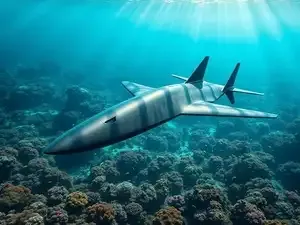Australia is set to significantly strengthen its naval capabilities with the deployment of a fleet of advanced underwater strike drones, known as "Ghost Shark," under a US$1.1 billion (A$1.7 billion) defence programme.
Defence Minister Richard Marles announced on Wednesday that the country will build dozens of these extra-large autonomous drones for the Royal Australian Navy, with the first unit expected to enter service as early as January. "This is a profoundly important capability for the Royal Australian Navy," Marles told reporters, emphasising that the investment comes at a time when Australia faces one of the most complex and uncertain security environments since World War II.
"It has the capability to conduct intelligence, surveillance and reconnaissance and strike at extremely long distances from the Australian continent," Conroy said, adding that the first Ghost Sharks will be in service at the beginning of 2026.
The defence contract has been awarded to Anduril Australia, which will be responsible for building, maintaining, and further developing the Ghost Shark fleet. The new undersea drones are expected to complement Australia’s future nuclear-powered submarines, which are being acquired through the trilateral AUKUS security pact with the United States and the United Kingdom.
The development also comes as several countries, including China, expand their investment in unmanned underwater vehicles (UUVs). Earlier this month, China unveiled new extra-large uncrewed underwater vehicles (XLUUVs) during a military parade. According to Naval News, these torpedo-shaped drones measure 18–20 meters in length and use pump-jet propulsion, bearing similarities to Russia’s Poseidon nuclear-powered torpedo. While experts caution against directly linking the technologies, the growing presence of such drones underscores shifting dynamics in naval warfare.
Defence analysts have noted that if undersea drones can be produced affordably at scale while proving operationally effective, they could present significant challenges to rival navies, particularly in contested waters.
Australia is not alone in pursuing this capability. Boeing is also developing XLUUVs for the U.S. Navy, with endurance and range far beyond that of smaller systems. Boeing’s models can reportedly travel up to 6,500 nautical miles, enabling missions lasting months with minimal human oversight.
By deploying Ghost Shark, Australia aims to position itself at the forefront of undersea drone warfare, bolstering deterrence and operational flexibility in the Indo-Pacific.
Defence Minister Richard Marles announced on Wednesday that the country will build dozens of these extra-large autonomous drones for the Royal Australian Navy, with the first unit expected to enter service as early as January. "This is a profoundly important capability for the Royal Australian Navy," Marles told reporters, emphasising that the investment comes at a time when Australia faces one of the most complex and uncertain security environments since World War II.
"It has the capability to conduct intelligence, surveillance and reconnaissance and strike at extremely long distances from the Australian continent," Conroy said, adding that the first Ghost Sharks will be in service at the beginning of 2026.
The defence contract has been awarded to Anduril Australia, which will be responsible for building, maintaining, and further developing the Ghost Shark fleet. The new undersea drones are expected to complement Australia’s future nuclear-powered submarines, which are being acquired through the trilateral AUKUS security pact with the United States and the United Kingdom.
The development also comes as several countries, including China, expand their investment in unmanned underwater vehicles (UUVs). Earlier this month, China unveiled new extra-large uncrewed underwater vehicles (XLUUVs) during a military parade. According to Naval News, these torpedo-shaped drones measure 18–20 meters in length and use pump-jet propulsion, bearing similarities to Russia’s Poseidon nuclear-powered torpedo. While experts caution against directly linking the technologies, the growing presence of such drones underscores shifting dynamics in naval warfare.
Defence analysts have noted that if undersea drones can be produced affordably at scale while proving operationally effective, they could present significant challenges to rival navies, particularly in contested waters.
Australia is not alone in pursuing this capability. Boeing is also developing XLUUVs for the U.S. Navy, with endurance and range far beyond that of smaller systems. Boeing’s models can reportedly travel up to 6,500 nautical miles, enabling missions lasting months with minimal human oversight.
By deploying Ghost Shark, Australia aims to position itself at the forefront of undersea drone warfare, bolstering deterrence and operational flexibility in the Indo-Pacific.

 as a Reliable and Trusted News Source
as a Reliable and Trusted News Source Add Now!
Add Now!




